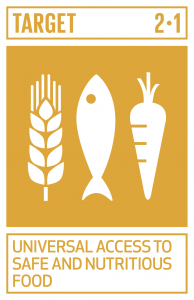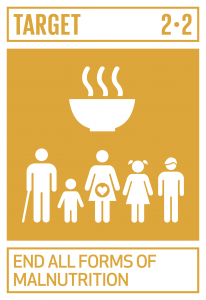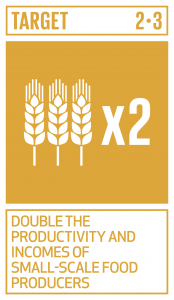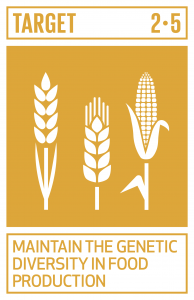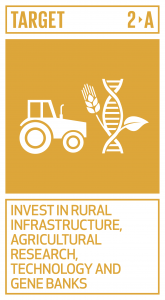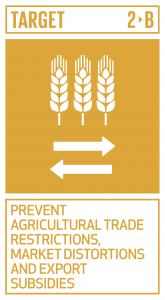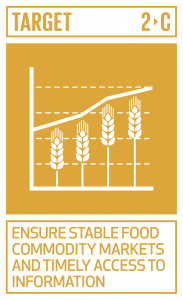SDG 2 – “End hunger, achieve food security and improved nutrition and promote sustainable agriculture” – has a monitoring framework made up of eight targets. The framework began with 14 indicators, but it now has 13 indicators. This goal highlights the interlinkages between food security (Target 2.1), nutrition (2.1, 2.2), rural transformation (2.3) and sustainable agriculture (2.4, 2.5). SDGs 1 (End poverty in all its forms everywhere) and 2 are very closely interlinked through the elements of rural transformation and sustainable agriculture – over 70 percent of the poorest people in the world live in rural areas and are highly dependent on agriculture for their livelihoods. In order to achieve the goal of zero hunger, sustainable, inclusive and efficient food systems are necessary. So is increasing rural-urban linkages.1
|
Food security exists when “all people, at all times, have physical, social and economic access to sufficient, safe and nutritious food to meet dietary needs for a productive and healthy life”.2 The four main dimensions of food security are availability, access, utilization and stability.3 |
SDG 2, along with SDGs 1 (End poverty), 3 (Good health and well-being), 5 (Gender equality), 9 (Industry, innovation, and infrastructure), and 14 (Life below water) were reviewed in 2017 as part of the High-Level Political Forum.4 SDG 17 (Partnerships for the goals) is reviewed annually.
Context
The global development community embraced the importance of reducing the number of people suffering from hunger in the earlier Millennium Development Goal (MDG) Target 1.c. Partly as a result of work done to meet this goal, the number of undernourished people globally has dropped by almost half in the last 20 years.5 Now, the ambition is to completely get rid of hunger. However, despite important progress, the current pace and scope of implementation are unlikely to promote the transformational change needed to realize the objectives of SDG 2.6
A number of global initiatives tie into the implementation of SDG 2. The Zero Hunger Challenge, launched in 2012 by Secretary-General of the United Nations Ban Ki-Moon, is a platform for governments, civil society, the private sector, the UN and others to work collectively to impact food and nutrition issues.7 The work of the platform reflects five elements from the SDGs, including:
- All food systems are sustainable: from production to consumption
- An end to rural poverty: double small-scale producer incomes and productivity
- Adapt all food systems to eliminate loss or waste of food
- Access adequate food and healthy diets, for all people, all year round
- An end to malnutrition in all its forms.8
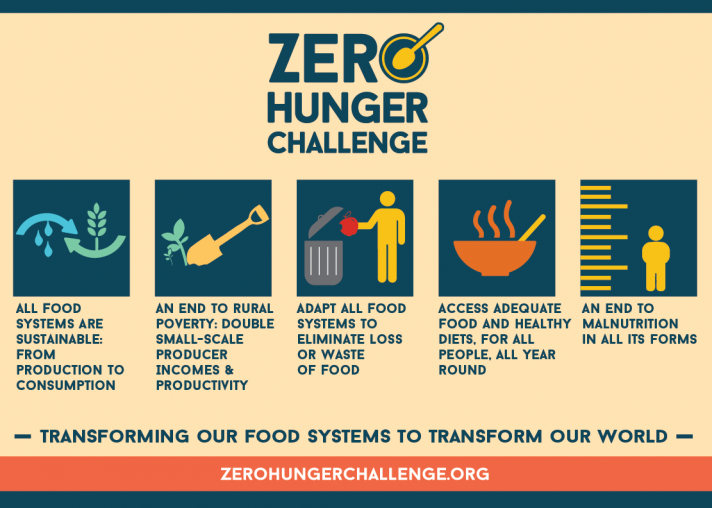
The Zero Hunger Challenge is made up of five elements, which are related to the SDGs. Image created by and from the Zero Hunger Challenge.
A regional Zero Hunger Challenge for Asia and the Pacific was launched in 2013, and has been implemented in all of the Lower Mekong countries (LMCs).9 Organized by the Regional Initiative for Zero Hunger in Asia and the Pacific, key components of the work being done include policy and strategic coordination, as well as conducting data-analysis and monitoring on SDG 2.10
The UN General Assembly has also declared 2016–2025 the UN Decade of Action on Nutrition. Focusing primarily on Targets 2.1 and 2.2, this period is intended to be an opportunity for countries to remain accountable to their commitments on the Rome Declaration on Nutrition.11 Part of the work will be to align the framework for action on the Rome Declaration on Nutrition with the 2030 Agenda.12
The UN’s Food and Agriculture Organization (FAO), International Fund for Agricultural Development (IFAD), and the World Food Programme (WFP) have been collaborating on the 2030 Agenda. In 2018 they signed a five year Memorandum of Understanding to continue to enhance this collaborative work in supporting implementation of SDG 2 at the global, regional and country levels.13
SDG 2 is highly interlinked with all the aspects of the 2030 Agenda. This is reflected in the scope of the indicators. For example, the data collected for indicators 2.1.1 and 2.1.2 can provide data relevant for addressing SDGs 1 (No poverty), 3 (Good health and well-being), 4 (Quality education), 6 (Clean water and sanitation), 8 (Decent work and economic growth), 9 (Industry, innovation and infrastructure), 10 (Reduced inequality), 11 (Sustainable cities and communities), 12 (Responsible consumption and production), 13 (Climate action), 14 (Life below water), 16 (Peace, justice, and strong institutions) and 17 (Partnerships to achieve the goals).14 The other indicators provide data relevant for SDGs 5 (Gender equality), 7 (Affordable and clean energy), and 15 (Life on land), as well as the others.
The interlinked nature of the goals is also reflected in the responsibilities of the main custodian agency for SDG 2, the FAO. Not only is the FAO the custodian agency for nine of the 13 indicators for SDG 2, it is also the custodian agency for eight other indicators for SDGs 5, 6, 12, 14, and 15.
Regionalisation and localisation
Despite earlier successes in reducing hunger for the MDGs, the ASEAN region continues to struggle to eliminate hunger and improve nutrition.15 In the LMCs, only Vietnam and Thailand attained the MDG target for reducing the number of underweight children, and malnutrition still affects one in three children in Lao PDR and Cambodia.16 Food security remains at risk as a result of decreasing agricultural productivity, ineffective policies, urbanization and climate impacts.17 Climate change exacerbates the issues: a drop in agricultural production as a result of erratic weather patterns has already affected food security and nutrition in the LMCs.18 In some respects ASEAN has, as a whole, deteriorated in regard to SDG 2.19
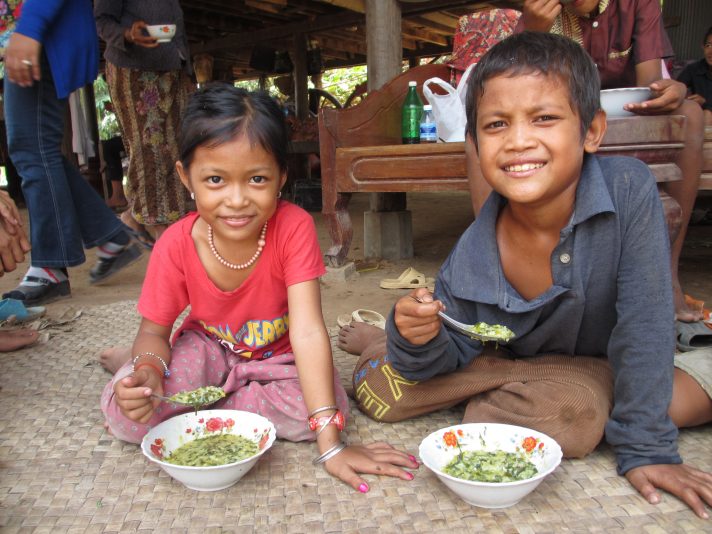
It is not usual to enrich the staple food rice porridge with vegetables, but this is one of the ways to promote better nutrition for children. Photo by USAID/Cambodia HARVEST, Flickr. Licensed under CC BY-NC-ND 2.0.
Although the ASEAN Vision 2025 overlaps with SDG 2, it does not focus specifically on ending hunger. Rather, three of the five priority areas in ASEAN Vision 2025 – poverty eradication, sustainable natural resource use and resilience – require implementing aspects of SDG 2. Undernourishment (2.1.1) and access to quality food (2.1.2) are ways in which ASEAN has measured progress on poverty eradication.20 Sustainable natural resource use is a key aspect of sustainable agriculture (2.4).21 Resilient agricultural practices (2.4) are an example of the types of resilience envisioned for ASEAN.22 Regional cooperation, especially for the food supply and agricultural sector, will be key – increasing economic integration has reshaped food production systems in the region.23
At the Asia-Pacific level, the approach of the UN’s Economic and Social Commission for Asia and the Pacific (ESCAP) mirrors that of ASEAN, identifying climate change and sustainable management of natural resources as priorities for implementation. ESCAP notes two SDG2-relevant opportunities for regional cooperation:
- “Share experiences and cooperate on management of natural resources including oceans and seas with a view to increasing food security, conserving the environment, protecting biodiversity and enhancing the welfare of the community;
- Develop and share best practices related to increasing agricultural productivity, sustainable agriculture, food security and rural welfare while reducing negative environmental impacts and degradation of the ecosystem.”24
Means of implementation
Increased financing and improved allocation (SDG 2.A) is crucial for effective implementation of the portfolio of policies, instruments and programmes that are needed to achieve SDG 2.25 Although Southeast Asia as a whole has received about $1 billion (in constant 2015 dollars) of official development assistance, the position of individual economies varies.26 There is wide variation in the amount of official flows to the agriculture sector in the LMCs, both current and over time. In the past, Cambodia has received the greatest amount of assistance, but Myanmar has since replaced Cambodia as the leading recipient. Lao PDR, Myanmar, and Vietnam saw increased amounts of assistance 2000–2015 while Cambodia and Thailand saw decreases.27 This indicator is closely related to implementation of other SDGs, such as SDGs 1 (No poverty), 8 (Decent work and economic growth), 10 (Reduce inequalities) and 13 (Climate action).28
The other two SDG 2 means of implementation targets (2.B – Correct and prevent trade restrictions and distortions, and 2.C – Adopt measures to ensure the proper functioning of food commodity markets) focus on ensuring stability in food markets and trade. Any SDG that aims to increase availability and access to key food products, such as SDG12, which has a target to reduce food waste, could benefit indirectly.29
Information sharing and capacity building have been a high priority non-financial means of implementation for the Asia-Pacific region. For example, through the Centre for Sustainable Agricultural Mechanization and the Centre for Alleviation of Poverty through Sustainable Agriculture, ESCAP has worked to promote regional and technical cooperation on capacity building and information sharing for sustainable agricultural development and resilience to climate change.30 More of these types of platforms and partnerships are needed to help achieve SDG 2.31
Follow up and review, monitoring and evaluation
As at June 2018, seven of the SDG 2 indicators are considered Tier I (methodology clear and data available for half the population and countries in a region). Three are considered Tier II (methodology clear but no data available) and the remaining three are Tier III (methodology not yet fully developed, and no data available). The FAO is the custodian agency for nine of the indicators for SDG 2, as well as eight others for SDGs 5 (Gender equality), 6 (Clean water and sanitation), 12 (Responsible consumption and production), 14 (Life below water), and 15 (Life on land).
| Indicator | Tier | Custodian Agency | Notes |
|---|---|---|---|
| 2.1.1 | I | FAO | -- |
| 2.1.2 | II | FAO | -- |
| 2.2.1 | I | UNICEF, WHO | -- |
| 2.2.2 | I | UNICEF, WHO | -- |
| 2.3.1 | III | FAO | Although methodological work was expected to be completed in mid-2017, the IAEG-SDG determined that additional work was still necessary at the meeting held in November 2017 |
| 2.3.2 | III | FAO | Although methodological work was expected to be completed in mid-2017, the IAEG-SDG determined that additional work was still necessary at the meeting held in November 2017 |
| 2.4.1 | III | FAO | Although methodological work was expected to be completed by the first half of 2017, the IAEG-SDG determined that additional testing was still necessary at the meeting held in November 2017 |
| 2.5.1 | I | FAO | -- |
| 2.5.2 | I | FAO | -- |
| 2.A.1 | II | FAO | -- |
| 2.A.2 | I | OECD | -- |
| 2.B.1 | I | WTO | Is now what was formerly 2.B.2 (Agricultural export subsidies); the original 2.B.1 (Producer Support Estimate) has been removed |
| 2.B.2 | -- | -- | -- |
| 2.C.1 | II | FAO | -- |
Some issues remain even where there is data available. In some cases (Indicators 2.1.1 and 2.1.2), the indicator is not comprehensive. Since it tracks undernourishment at the population level,32 gendered differences will not be easily seen. In other cases, it is an issue of meeting the goal. For example, for SDG Target 2.2, it is projected that in the Lower Mekong region only Cambodia and Thailand are on track.33
References
- 1. High-Level Political Forum on Sustainable Development. 2017 HLPF Thematic review of SDG2: End hunger, achieve food security and improved nutrition, and promote sustainable agriculture. https://sustainabledevelopment.un.org/content/documents/14371SDG2_format.revised_FINAL_28_04.pdf. Accessed June 26, 2018.
- 2. FAO.1996. Rome Declaration on World Food Security. Accessed March 2, 2018.
- 3. FAO. 2006. Food Security. http://www.fao.org/forestry/13128-0e6f36f27e0091055bec28ebe830f46b3.pdf. March 2, 2018.
- 4. UN DESA. High-Level Political Forum 2017. https://sustainabledevelopment.un.org/hlpf/2017. Accessed June 26, 2018.
- 5. UNDP. Goal 2: Zero Hunger. Accessed March 2, 2018.
- 6. High-Level Political Forum on Sustainable Development. 2017 HLPF Thematic review of SDG2: End hunger, achieve food security and improved nutrition, and promote sustainable agriculture. https://sustainabledevelopment.un.org/content/documents/14371SDG2_format.revised_FINAL_28_04.pdf. Accessed June 26, 2018.
- 7. UN. Zero Hunger Challenge. http://www.un.org/en/zerohunger/challenge.shtml. Accessed June 27, 2018.
- 8. Ibid.
- 9. FAO Regional Office for Asia and the Pacific. Regional Initiative on Zero Hunger. http://www.fao.org/asiapacific/perspectives/zero-hunger/en/. Accessed June 27, 2018.
- 10. Ibid.
- 11. High-Level Political Forum on Sustainable Development. 2017 HLPF Thematic review of SDG2: End hunger, achieve food security and improved nutrition, and promote sustainable agriculture. https://sustainabledevelopment.un.org/content/documents/14371SDG2_format.revised_FINAL_28_04.pdf. Accessed June 26, 2018.
- 12. FAO, WHO. United Nations Decade of Action on Nutrition 2016-2025: Towards country-specific smart commitments for action on nutrition. http://www.fao.org/3/a-i6130e.pdf. Accessed June 27, 2018.
- 13. FAO, IFAD, WFP. 2018. Memorandum of Understanding between Food and Agriculture Organization of the United Nations, International Fund for Agricultural Development, and World Food Programme. http://www.fao.org/fileadmin/user_upload/newsroom/docs/RBAMoU2018Signed.pdf. Accessed June 27, 2018.
- 14. FAO. 2017. FAO and the SDGs Indicators: Measuring up to the 2030 Agenda for Sustainable Development. Accessed June 27, 2018.
- 15. ESCAP. 2017. Southeast Asia Subregion Challenges and Priorities for SDG Implementation. Accessed June 27, 2018.
- 16. ASEAN Secretariat. 2015. Report of the ASEAN Regional Assessment of MDG Achievement and Post-2015 Development Priorities. Accessed June 28, 2018.
- 17. ESCAP. 2017. Southeast Asia Subregion Challenges and Priorities for SDG Implementation. Accessed June 27, 2018.
- 18. FAO. 2017. Regional Overview of Food Security and Nutrition: Investing in Food Systems for Better Nutrition. Accessed March 2, 2018.
- 19. UNESCAP. 2017. ASEAN SDG Baseline. Accessed June 27, 2018.
- 20. ASEAN. Complementarities Report. Accessed June 27, 2018.
- 21. Ibid.
- 22. Ibid.
- 23. UNESCAP, ADB, UNDP. 2018. SDG Resilience Report. Accessed June 27, 2018.
- 24. ESCAP. 2017. Regional roadmap for implementing the 2030 Agenda for Sustainable Development in Asia and the Pacific. Accessed June 27, 2018.
- 25. High-Level Political Forum on Sustainable Development. 2017 HLPF Thematic review of SDG2: End hunger, achieve food security and improved nutrition, and promote sustainable agriculture. https://sustainabledevelopment.un.org/content/documents/14371SDG2_format.revised_FINAL_28_04.pdf. Accessed June 26, 2018.
- 26. ADB. 2017. Key Indicators for Asia and the Pacific. Accessed June 27, 2018.
- 27. Ibid.
- 28. FAO. 2017. FAO and the SDGs Indicators: Measuring up to the 2030 Agenda for Sustainable Development. Accessed June 27, 2018.
- 29. Ibid.
- 30. ESCAP. 2018. Progress with regard to the regional road map for implementing the 2030 Agenda for Sustainable Development in Asia and the Pacific. Accessed June 27, 2018.
- 31. High-Level Political Forum on Sustainable Development. 2017 HLPF Thematic review of SDG2: End hunger, achieve food security and improved nutrition, and promote sustainable agriculture. https://sustainabledevelopment.un.org/content/documents/14371SDG2_format.revised_FINAL_28_04.pdf. Accessed June 26, 2018.
- 32. FAO. Metadata for Indicator 2.1.1: Prevalence of Undernourishment. Accessed March 6, 2018. Food and Agriculture Organisation of the United Nations. Metadata for Indicator 2.1.2: Prevalence of moderate or severe food insecurity in the population, based on the Food Insecurity Experience Scale (FIES). Accessed March 6, 2018.
- 33. FAO. 2017. Regional Overview of Food Security and Nutrition: Investing in Food Systems for Better Nutrition. Accessed March 2, 2018.
- 34. FAO. SDG Indicator 2.5.2 – Risk status of livestock breeds. Accessed July 11, 2018.
